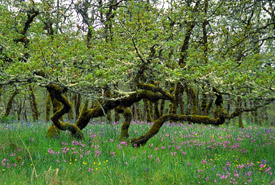Garry oak parkland and savannah

Garry oak, Cowichan Garry Oak Preserve, BC (Photo by Tim Ennis/NCC)
The beautiful Cowichan Valley inspires many visitors to return to its open spaces and forested hills. Bird enthusiasts and conservationists alike are overjoyed that among those who have returned this year are three bluebirds — the first of their kind to migrate on their own back to the valley since the 1990s.
Two of the birds had been brought to the Cowichan Garry Oak Preserve in 2012 as juveniles, while the third had hatched on the property. All three migrated south for the winter, and we were left to wonder when and if they would return.
These birds are part of Bring Back the Bluebirds, a multi-partner project that aims to re-establish a self-sustaining bluebird population on southern Vancouver Island and the Gulf Islands. Their reintroduction would not have been possible without the restoration and management efforts of the Nature Conservancy of Canada (NCC) in the extremely rare Garry oak habitat at the Cowichan Garry Oak Preserve.
Ecological significance
Garry oak habitat is composed of a mix of open rocky areas, grasslands, Douglas-fir stands and woodlands. Parklands are areas with 10-20 per cent forest cover, whereas savannahs are prairies with scattered trees on them comprising approximately 10 per cent forest cover.
The dry climate and mix of vegetation in this habitat produces rich, dark soil that favours the growth of a number of rare plant and tree species, including Garry oak.
Garry oak is the only species of oak native to British Columbia. Its range is limited to a very narrow strip of sub-Mediterranean rain shadow climate that extends down the eastern margin of Vancouver Island and throughout the Southern Gulf Islands in BC, and as far south as the San Joaquin Valley in California.
Garry oak acorns provide an important source of food for Columbian black-tailed deer, band-tailed pigeon, Stellar's jay and other species. Also, the larvae of the threatened propertius duskywing butterfly feed exclusively on Garry oak leaves.
The trunk and limbs of Garry oak are almost always covered in a thick, patchy layer of moss, which provides habitat for many species of insects. These in turn provide food for a wide variety of birds, such as brown creeper and red-breasted nuthatch.
Garry oaks occasionally drop large limbs, exposing areas of rot in their trunks that are quickly adopted as shelters by woodpeckers and cavity nesting songbirds.
Species
Every plant community identified with Garry oak is listed in British Columbia as "critically imperiled."
In all, more than 100 species associated with Garry oak habitats are listed as either threatened, endangered, extirpated or extinct. Most of the endangered or threatened species are plants, with some butterflies as well.
Notable examples include:
- yellow prairie violet
- Howell's triteleia
- deltoid balsamroot
- Taylor's checkerspot
- chocolate lily
Many of the extirpated (locally extinct) species are cavity-nesting grassland birds such as:
- western bluebird
- Lewis' woodpecker
- acorn woodpecker
- streaked horned lark
Threats
Less that one per cent of low-elevation Garry oak habitat and approximately five per cent of upland habitat remain in Canada today. This makes the Garry oak ecosystem one of the most endangered in Canada.
Agricultural conversion and urban and residential development have been the major cause of the loss of Garry oak habitat. Encroaching development continues to pose a threat to this sensitive ecosystem, as well as introduced pests such as jumping gall wasp and oak-leaf phylloxeran.
What is NCC doing to protect this habitat?
NCC's Cowichan Garry Oak Preserve is one of the last and best remnants of Garry oak ecosystem and its associated biodiversity in the world. The preserve protects notable populations of rare plants and butterflies, which have attracted researchers from across North America.
More on the Cowichan Garry Oak Preserve >
NCC has also conserved the 100-acre (40-hectare) Chase Woods property, which is home to a number of rare species and habitat types, including the globally imperilled Garry oak plant community.
A natural partnership
TD Forests is helping to protect forests across Canada.





